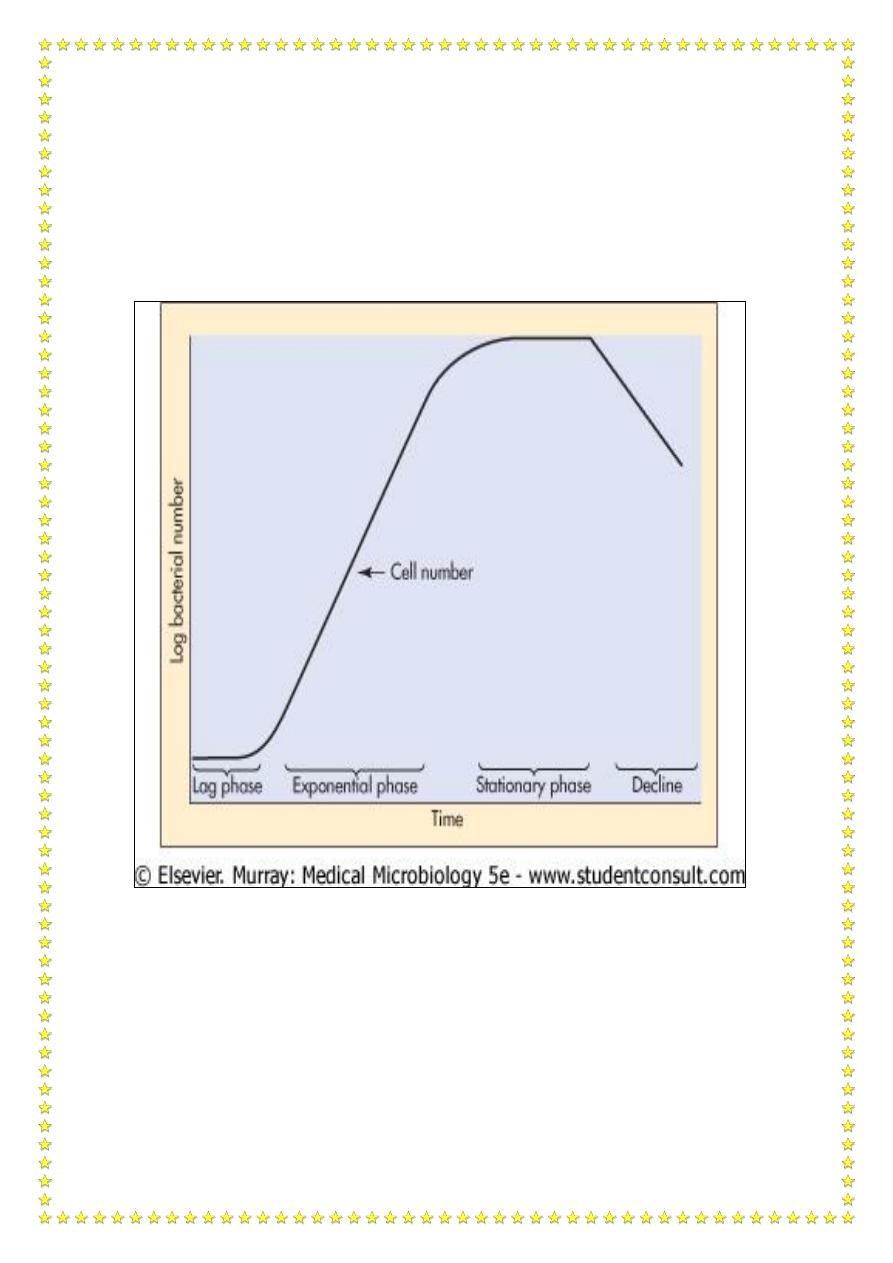
1
بسم هللا الرحمن الرحيم
Thi-qar university subject:Bacteria
College of medicine
Microbiology dept. date / /
Lec. 1
Bacterial physiology & metabolism
Bacterial metabolism
This mean the sum of anabolic processes (synthesis of cellular
constituents requiring energy) and catabolic processes (breakdown of
cellular constituents with concomitant release of waste products and
energy-rich compounds). is heterotrophic for pathogenic bacteria. varies
depending on the nutritional environment.
The physiology of bacteria include many processes that effect in their
survival :-
1- Energy production :-
There are three major mechanisms for generating of metabolic energy :-
a :- Fermentation :-
The fermentation of ATP is not coupled to the transfer of electron ,
fermentation is characterized by substrate phosphorylation (( is an
enzymatic process in which phosphate bond donated directly to ADP by a
phosphorylated metabolic intermediate that formed by metabolic
arrangement of fermentable substrate e.g. glucose , lactose or arginine .
b :- Respiration :-
Chemical reaction of an oxidant (( electron acceptor )) through a
specific series of electron carriers in the membrane establishes the proton
motive force across the bacterial membrane .
The reductant (( electron donor )) may organic or inorganic substrate
e.g. lactic acid serves as a reductant for some organisms , while hydrogen
gas is a reductant for other organisms .
The gaseous oxygen is often employed as an oxidant but the alternative
oxidant that are employed by some organisms include : CO
2
, sulfate and
nitrate .

2
C:- Photosynthesis :-
The organism used sun light to produce energy.
2- Growth :-
Growth is orderly increase in the sum of all components of an
organism , thus an increase in size that is occur due to cell uptake of water
or nutrients is not considerable as true growth , in the unicellular organisms
growth lead to an increase in the number of individuals making up a
population or culture .
* Measurement of microbial growth :-
There are 2 parameters used to determine microbial growth :
a :- Cell concentration :-
The number of viable cells per unit volume of culture , this method
depend on turbidity of culture which measuring by photoelectric means ,
this parameter used in the study of genetic and inactivation cells .
b :- Biomass concentration density :-
This mean (( dry weight of cells per unit volume of culture )) and can
be measured by determine dry weight of microbial culture after it has been
washed with D.W. , this parameter used to study of microbial biochemistry
and nutrition .
* Factors that effect on growth :-
1:- Nutrition :-
Bacteria like all cells require nutrients for maintains of their
metabolism and cell division , the bacteria differ widely in their nutritional
requirements two groups can be distinguished :-
a:- Autotrophs :-
as a
2
These bacteria can utilize simple inorganic substance e.g. CO
source of carbon & ammonium salts as a sources of nitrogen from which
they synthesize organic substances e.g. protein & carbohydrates .
The energy needed for their metabolism is obtained from light or
oxidation of inorganic substances , These are free living , non parasitic
organism of no direct medical importance .
b:- Heterotrophs :-
These bacteria require complex organic substances like : sugars
proteins for their metabolism , these substances derived from plant or
animal sources . All medical importance bacteria are heterotrophs which is

3
live in or on the animals body so they called parasitic bacteria , many of
heterotrophs can be grow in a simple media containing peptone or meat
extract as in broth or nutrient agar , others require complex organic
materials such as blood & serum , these media are called enrichment
media .
2:- Growth factors & essential metabolites :-
Many pathogenic species require for growth to essential substances in
small amount e.g. vitamins , amino acids , purines & pyrimidines that
present in the host tissues . These substances can not be synthesized by
bacteria
&
must
be
add
to
the
culture
media
.
Several types of bacteria secrete enzymes e.g. lipases & proteases
which can breakdown extracellular nutrient materials into simple
molecules to yield their energy , other products used to buildup structural
components and essential macromolecules for cell metabolism .
3:- Gaseous requirement of bacteria :-
According to their oxygen requirement , bacteria was divided into 4
groups :-
2
the present of O
some bacteria grow only in
-
Obligate aerobes :
-
a
because their energy generating system depend on oxygen as a hydrogen
acceptor e.g. Mycobacterium tuberculosis & Pseudomonas aeruginosa .
b-Facultative anaerobes :- these bacteria are grow in the presence or
absence of O
2
e.g. Escherichia coli .
c- Obligate anaerobes :- these bacteria can grow only in the complete
.
tetani
Clostridium
& die in its present e.g.
2
O
.
g
e.
absence
, two toxic products are produced , hydrogen
2
In the presence of O
the
) , anaerobic bacteria lack
3
) and super oxide ion ( O
2
O
2
peroxide ( H
enzymes catalase & superoxide dismutase that breakdown these
molecules , so in these organisms the final hydrogen acceptor in energy
.
2
metabolism is organic or inorganic molecules other than O
tension
2
ese require for growth a low O
Th
-
aerophilic bacteria :
-
Micro
-
d
lower than that present in the atmosphere e.g. Campylobacter jejuni .
CO
2
in a small amount as that present in air is required by most
bacteria , certain species like Brucella abortus & the pathogenic Neisseria
require higher concentration of CO
2
( 5 – 20 )% for their growth .

4
4:- Temperature for growth :-
Bacteria differ as regards the optimal temperature for their growth n
can b divide into :-
a- Thermophilic bacteria :- grow in a temperature higher than 55 C° .
b- Mesophilic bacteria :- grow in temperature between ( 25-42 ) C° , the
optimum is 37 C° , these group include medical important bacterial
species .
c- Psychrophilic bacteria :- grow in a temperature lower than 20 C ° .
5 :- Hydrogen ion concentration :-
Most pathogenic species of bacteria can grow at narrow range of pH
( 7.2 – 7.6 ) . However , few spp. like Vibrio cholerae grow at an alkaline
pH 8 & lactobacilli in the acidic pH 4 .
* Bacterial reproduction :-
Bacteria reproduce by binary fission , one cell divide into 2 daughter
cells similar in the genetic characters to the mother cell .
The process start by duplication of chromosome , the two sister
chromosomes become attach to the cytoplasmic membrane at the
mesosome across the bacterial cell , these are separated by ingrowing
newly synthesized cell membrane & cell wall forming septum divides the
cell into 2 daughter cells .
The new cells may remain temporarily attached before complete
separation to certain characteristic arrangement e.g. clusters , pairs and
chain .
The characteristic growth curve include four phases :-
1 – Lag phase :-
In this phase no cell division occurs , the bacteria adept to the new
environment by formation of new enzymes & macromolecules which
needed for replication.
2 – Logarithmic or exponential phase :-
During this phase rapid cell division is occur , increase biomass & the
number of bacterial cells increase steadily by time , many antibiotics are
effective during this phase e.g. ß- lactam drugs such as penicillin that act
when the cell is synthesized peptidoglycan .
3 – Stationary phase :-
The nutrients in the medium are exhausted & toxic products
accumulated , so the growth rate is decrease , the number of dying cells
equal to that of newly formed cells & the number of living bacteria remain
constant .

5
4 – Decline phase :-
As the exhausted of nutrients & accumulation of toxic products , the
death rate exceeds the multiplication rate and the number of living bacteria
decrease steadily .



